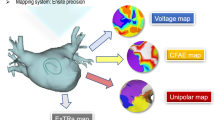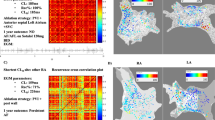Abstract
Focal activation is believed to be an atrial fibrillation (AF) driver; however, little is known about whether all focal activations are necessary for AF persistence. The purpose of this study was to assess the electrical nature of focal activation and identify high-priority focal activations using a novel mapping system (CARTOFINDER). Thirty-five patients with persistent AF who underwent catheter ablation were assessed. Cycle length (CL) and CL standard deviation (CLSD) on unipolar recordings and voltage amplitude and electrogram morphologies on bipolar recordings were evaluated at all points of interest. The most frequent CL at each mapping site was defined as the dominant CL. We identified dominant focal activations (DFAs) that had a shorter dominant CL on the integrated CARTOFINDER map. The effect of elimination of DFAs on AF maintenance was assessed by the composite endpoint (termination to sinus rhythm, organization of the rhythm to atrial tachycardia, and AF CL slowing). In all, 450 focal activations were identified among 10,868 points, and 50.4% of focal activations were DFAs. Focal activations showed relatively long CL and regularity with short CLSD. Most focal activations showed an isoelectric baseline and were located outside of the fractionated electrogram area. Both DFAs and non-DFAs were typically observed in the normal voltage range. Elimination of DFAs was achieved in 19 (54.3%) patients, with a remarkable impact on AF maintenance (68.4% vs. 25.0%, p = 0.018). In conclusion, DFAs may play an important role in AF maintenance and could be an attractive therapeutic target for AF.







Similar content being viewed by others
References
Clarnette JA, Brooks AG, Mahajan R, Elliott AD, Twomey DJ, Pathak RK, Kumar S, Munawar DA, Young GD, Kalman JM, Lau DH, Sanders P (2018) Outcomes of persistent and long-standing persistent atrial fibrillation ablation: a systematic review and meta-analysis. Europace 20:f366–f376
Calkins H, Hindricks G, Cappato R, Kim YH, Saad EB, Aguinaga L, Akar JG, Badhwar V, Brugada J, Camm J, Chen PS, Chen SA, Chung MK, Nielsen JC, Curtis AB, Davies DW, Day JD, d’Avila A, de Groot N, Di Biase L, Duytschaever M, Edgerton JR, Ellenbogen KA, Ellinor PT, Ernst S, Fenelon G, Gerstenfeld EP, Haines DE, Haissaguerre M, Helm RH, Hylek E, Jackman WM, Jalife J, Kalman JM, Kautzner J, Kottkamp H, Kuck KH, Kumagai K, Lee R, Lewalter T, Lindsay BD, Macle L, Mansour M, Marchlinski FE, Michaud GF, Nakagawa H, Natale A, Nattel S, Okumura K, Packer D, Pokushalov E, Reynolds MR, Sanders P, Scanavacca M, Schilling R, Tondo C, Tsao HM, Verma A, Wilber DJ, Yamane T (2017) 2017 HRS/EHRA/ECAS/APHRS/SOLAECE expert consensus statement on catheter and surgical ablation of atrial fibrillation. Heart Rhythm 14:e275–e444
Narayan SM, Krummen DE, Shivkumar K, Clopton P, Rappel WJ, Miller JM (2012) Treatment of atrial fibrillation by the ablation of localized sources: CONFIRM (conventional ablation for atrial fibrillation with or without focal impulse and rotor modulation) trial. J Am Coll Cardiol 60:628–636
Takahashi Y, Yamashita S, Suzuki M, Yabe K, Hirao K (2018) Efficacy of catheter ablation of focal sources in persistent atrial fibrillation. J Cardiovasc Electrophysiol 29:559–565
Hansen BJ, Zhao J, Csepe TA, Moore BT, Li N, Jayne LA, Kalyanasundaram A, Lim P, Bratasz A, Powell KA, Simonetti OP, Higgins RS, Kilic A, Mohler PJ, Janssen PM, Weiss R, Hummel JD, Fedorov VV (2015) Atrial fibrillation driven by micro-anatomic intramural re-entry revealed by simultaneous sub-epicardial and sub-endocardial optical mapping in explanted human hearts. Eur Heart J 36:2390–2401
Zaman JAB, Sauer WH, Alhusseini MI, Baykaner T, Borne RT, Kowalewski CAB, Busch S, Zei PC, Park S, Viswanathan MN, Wang PJ, Brachmann J, Krummen DE, Miller JM, Rappel WJ, Narayan SM, Peters NS (2018) Identification and characterization of sites where persistent atrial fibrillation is terminated by localized ablation. Circ Arrhythm Electrophysiol 11:e005258
Lee S, Sahadevan J, Khrestian CM, Cakulev I, Markowitz A, Waldo AL (2015) Simultaneous biatrial high-density (510–512 electrodes) epicardial mapping of persistent and long-standing persistent atrial fibrillation in patients: new insights into the mechanism of its maintenance. Circulation 132:2108–2117
Honarbakhsh S, Schilling RJ, Providencia R, Keating E, Sporton S, Lowe M, Lambiase PD, Chow A, Earley MJ, Hunter RJ (2019) Automated detection of repetitive focal activations in persistent atrial fibrillation: validation of a novel detection algorithm and application through panoramic and sequential mapping. J Cardiovasc Electrophysiol 30:58–66
Honarbakhsh S, Schilling RJ, Dhillon G, Ullah W, Keating E, Providencia R, Chow A, Earley MJ, Hunter RJ (2018) A novel mapping system for panoramic mapping of the left atrium: application to detect and characterize localized sources maintaining atrial fibrillation. JACC Clin Electrophysiol 4:124–134
Verma A, Sarkozy A, Skanes A, Duytschaever M, Bulava A, Urman R, Amos YA, Potter T (2018) Characterization and significance of localized sources identified by a novel automated algorithm during mapping of human persistent atrial fibrillation. J Cardiovasc Electrophysiol 29:1480–1488
Nogami A, Kurita T, Abe H, Ando K, Ishikawa T, Imai K, Usui A, Okishige K, Kusano K, Kumagai K, Goya M, Kobayashi Y, Shimizu A, Shimizu W, Shoda M, Sumitomo N, Seo Y, Takahashi A, Tada H, Naito S, Nakazato Y, Nishimura T, Nitta T, Niwano S, Hagiwara N, Murakawa Y, Yamane T, Aiba T, Inoue K, Iwasaki Y, Inden Y, Uno K, Ogano M, Kimura M, Si S, Sasaki S, Satomi K, Shiga T, Suzuki T, Sekiguchi Y, Soejima K, Takagi M, Chinushi M, Nishi N, Noda T, Hachiya H, Mitsuno M, Mitsuhashi T, Miyauchi Y, Miyazaki A, Morimoto T, Yamasaki H, Aizawa Y, Ohe T, Kimura T, Tanemoto K, Tsutsui H, Mitamura H (2021) JCS/JHRS 2019 guideline on non-pharmacotherapy of cardiac arrhythmias. J Arrhythm 37:709–870
Yanagisawa S, Inden Y, Fujii A, Sakamoto Y, Tomomatsu T, Mamiya K, Okamoto H, Shibata R, Murohara T (2019) Prothrombotic responses after catheter ablation for atrial fibrillation during uninterrupted oral anticoagulant agent administration. JACC Clin Electrophysiol 5:1418–1427
Sanders P, Morton JB, Davidson NC, Spence SJ, Vohra JK, Sparks PB, Kalman JM (2003) Electrical remodeling of the atria in congestive heart failure: electrophysiological and electroanatomic mapping in humans. Circulation 108:1461–1468
Ohe M, Haraguchi G, Kumanomido J, Obuchi A, Hori K, Ito S, Ueno S, Fukumoto Y (2019) New tailored approach using a revised assessment of fragmented potentials for persistent atrial fibrillation: early area defragmentation by modified CFAE module. J Cardiovasc Electrophysiol 30:844–853
Konings KT, Smeets JL, Penn OC, Wellens HJ, Allessie MA (1997) Configuration of unipolar atrial electrograms during electrically induced atrial fibrillation in humans. Circulation 95:1231–1241
Nademanee K, McKenzie J, Kosar E, Schwab M, Sunsaneewitayakul B, Vasavakul T, Khunnawat C, Ngarmukos T (2004) A new approach for catheter ablation of atrial fibrillation: mapping of the electrophysiologic substrate. J Am Coll Cardiol 43:2044–2053
Pappone C, Ciconte G, Vicedomini G, Mangual JO, Li W, Conti M, Giannelli L, Lipartiti F, McSpadden L, Ryu K, Guazzi M, Menicanti L, Santinelli V (2018) Clinical outcome of electrophysiologically guided ablation for nonparoxysmal atrial fibrillation using a novel real-time 3-dimensional mapping technique: results from a prospective randomized trial. Circ Arrhythm Electrophysiol 11:e005904
Daoud EG, Bogun F, Goyal R, Harvey M, Man KC, Strickberger SA, Morady F (1996) Effect of atrial fibrillation on atrial refractoriness in humans. Circulation 94:1600–1606
Sanders P, Berenfeld O, Hocini M, Jaïs P, Vaidyanathan R, Hsu LF, Garrigue S, Takahashi Y, Rotter M, Sacher F, Scavée C, Ploutz-Snyder R, Jalife J, Haïssaguerre M (2005) Spectral analysis identifies sites of high-frequency activity maintaining atrial fibrillation in humans. Circulation 112:789–797
Jiang R, Buch E, Gima J, Upadhyay GA, Nayak HM, Beaser AD, Aziz Z, Shivkumar K, Tung R (2019) Feasibility of percutaneous epicardial mapping and ablation for refractory atrial fibrillation: Insights into substrate and lesion transmurality. Heart Rhythm 16:1151–1159
Kaneko S, Yamabe H, Hoshiyama T, Kanazawa H, Ito M, Kanemaru Y, Kiyama T, Tsujita K (2019) Analysis of the preferable site and stability of rotational reentry: its role for the maintenance of atrial fibrillation. Heart Vessels 34:1014–1023
Funding
None.
Author information
Authors and Affiliations
Corresponding author
Ethics declarations
Conflict of interest
The authors declare that they have no conflict of interest.
Ethics approval
This study was approved by the institutional ethics committee at Nagoya University Hospital.
Consent to participate
All patients provided written informed consent prior to the procedure.
Additional information
Publisher's Note
Springer Nature remains neutral with regard to jurisdictional claims in published maps and institutional affiliations.
Rights and permissions
About this article
Cite this article
Shimojo, M., Inden, Y., Yanagisawa, S. et al. Identification of high priority focal activations in persistent atrial fibrillation using a novel mapping strategy. Heart Vessels 37, 840–853 (2022). https://doi.org/10.1007/s00380-021-01977-x
Received:
Accepted:
Published:
Issue Date:
DOI: https://doi.org/10.1007/s00380-021-01977-x




